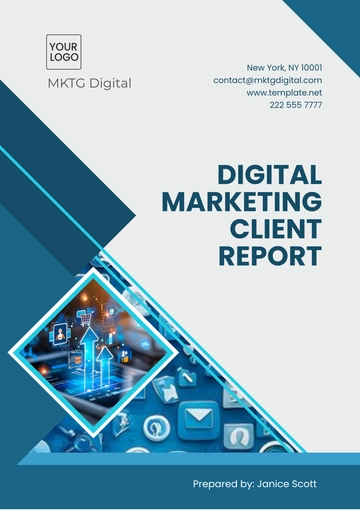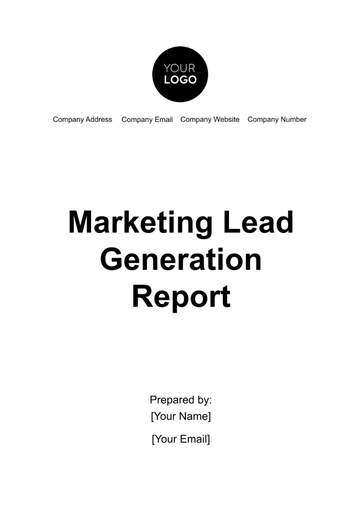Free Marketing Design Research Report

Prepared by | [Your Name] |
Date | September 10, 2060 |
I. Executive Summary
This Marketing Design Research Report delivers a comprehensive analysis of design preferences and trends since 2050, aimed at informing contemporary marketing strategies. Key findings indicate a significant shift towards sustainable design choices, heightened consumer expectations for personalized content, and the increasing use of immersive technologies such as augmented reality (AR) and virtual reality (VR). These trends are reshaping consumer engagement and retention strategies, offering valuable insights for businesses looking to enhance their market presence.
II. Research Objectives
A. Goals
The primary objective of this research is to explore and identify the evolving design preferences and expectations of today’s consumers. This involves a detailed examination of the elements that attract and influence customer engagement, loyalty, and retention in a competitive market landscape.
B. Questions
The research seeks to address several critical questions, including:
What are the predominant design trends emerging in the marketing space?
How do consumers perceive various design and technology integrations?
What role does sustainability play in shaping design preferences among consumers?
III. Methodology
To obtain comprehensive data, this research employed a multifaceted approach combining both qualitative and quantitative methods, including:
Online Surveys: Targeting a diverse range of consumer demographics to gather quantitative data on design preferences and trends.
Focus Groups: Engaging marketing experts and design specialists to obtain qualitative insights into consumer behavior and design expectations.
Market Trend Analysis: Review contemporary market trends and consumer reports from 2050 onwards to contextualize findings within the broader marketing landscape.
IV. Key Findings
The research yielded several pivotal insights that are essential for effective marketing design:
Sustainability: A substantial 85% of respondents expressed a preference for brands that adopt eco-friendly design practices, highlighting the critical importance of sustainability in consumer choice.
Personalization: The study found that personalized content, facilitated by AI technologies, significantly enhances consumer engagement, with 78% of participants indicating a preference for tailored marketing experiences.
Immersive Technology: There is a growing acceptance and integration of immersive technologies, with 65% of consumers indicating a positive response to AR and VR applications in marketing strategies.
V. Analysis and Interpretation
The findings illustrate a strong trend towards eco-consciousness in design, indicating that consumers are increasingly prioritizing sustainable practices in their purchasing decisions. The importance of personalization is amplified by advancements in AI technology, which enable brands to foster deeper connections with their audiences. Furthermore, immersive technologies like AR are transforming customer interactions, providing more engaging and memorable experiences.
Trend | Consumer Preference (%) | Impact Level |
|---|---|---|
Sustainability | 85 | High |
Personalization | 78 | Medium |
Immersive Technology | 65 | High |
VI. Recommendations
Based on the insights gained from this research, the following strategic actions are recommended:
Integrate Sustainable Practices: Companies should adopt eco-friendly design processes to resonate with consumer values and enhance brand loyalty.
Leverage AI for Personalization: Investing in AI-driven personalization strategies can improve user engagement and create more meaningful customer interactions.
Invest in Immersive Technologies: Brands should explore innovative applications of AR and VR to develop cutting-edge marketing campaigns that captivate and engage consumers.
VII. Conclusion
This research highlights the necessity for marketers to remain attuned to evolving design trends to maintain a competitive edge. By understanding and adapting to consumer preferences, companies can develop more effective, engaging, and sustainable marketing strategies. The next steps involve implementing these recommendations and continuously monitoring consumer feedback to refine marketing approaches over time.
VIII. Appendices
Additional data supporting the research findings is available in the following appendices:
Appendix A: Detailed survey response data
Appendix B: Focus group discussion transcripts
Appendix C: Source references and further readings
- 100% Customizable, free editor
- Access 1 Million+ Templates, photo’s & graphics
- Download or share as a template
- Click and replace photos, graphics, text, backgrounds
- Resize, crop, AI write & more
- Access advanced editor
Template.net's Marketing Design Research Report Template is a perfect choice for marketing professionals. This editable and customizable template features sections for marketing metrics, analysis, and design insights. It allows marketers to present research findings clearly and effectively. Editable in our Ai Editor Tool, this template provides a structured format to present audience insights and design strategies.
You may also like
- Sales Report
- Daily Report
- Project Report
- Business Report
- Weekly Report
- Incident Report
- Annual Report
- Report Layout
- Report Design
- Progress Report
- Marketing Report
- Company Report
- Monthly Report
- Audit Report
- Status Report
- School Report
- Reports Hr
- Management Report
- Project Status Report
- Handover Report
- Health And Safety Report
- Restaurant Report
- Construction Report
- Research Report
- Evaluation Report
- Investigation Report
- Employee Report
- Advertising Report
- Weekly Status Report
- Project Management Report
- Finance Report
- Service Report
- Technical Report
- Meeting Report
- Quarterly Report
- Inspection Report
- Medical Report
- Test Report
- Summary Report
- Inventory Report
- Valuation Report
- Operations Report
- Payroll Report
- Training Report
- Job Report
- Case Report
- Performance Report
- Board Report
- Internal Audit Report
- Student Report
- Monthly Management Report
- Small Business Report
- Accident Report
- Call Center Report
- Activity Report
- IT and Software Report
- Internship Report
- Visit Report
- Product Report
- Book Report
- Property Report
- Recruitment Report
- University Report
- Event Report
- SEO Report
- Conference Report
- Narrative Report
- Nursing Home Report
- Preschool Report
- Call Report
- Customer Report
- Employee Incident Report
- Accomplishment Report
- Social Media Report
- Work From Home Report
- Security Report
- Damage Report
- Quality Report
- Internal Report
- Nurse Report
- Real Estate Report
- Hotel Report
- Equipment Report
- Credit Report
- Field Report
- Non Profit Report
- Maintenance Report
- News Report
- Survey Report
- Executive Report
- Law Firm Report
- Advertising Agency Report
- Interior Design Report
- Travel Agency Report
- Stock Report
- Salon Report
- Bug Report
- Workplace Report
- Action Report
- Investor Report
- Cleaning Services Report
- Consulting Report
- Freelancer Report
- Site Visit Report
- Trip Report
- Classroom Observation Report
- Vehicle Report
- Final Report
- Software Report





























